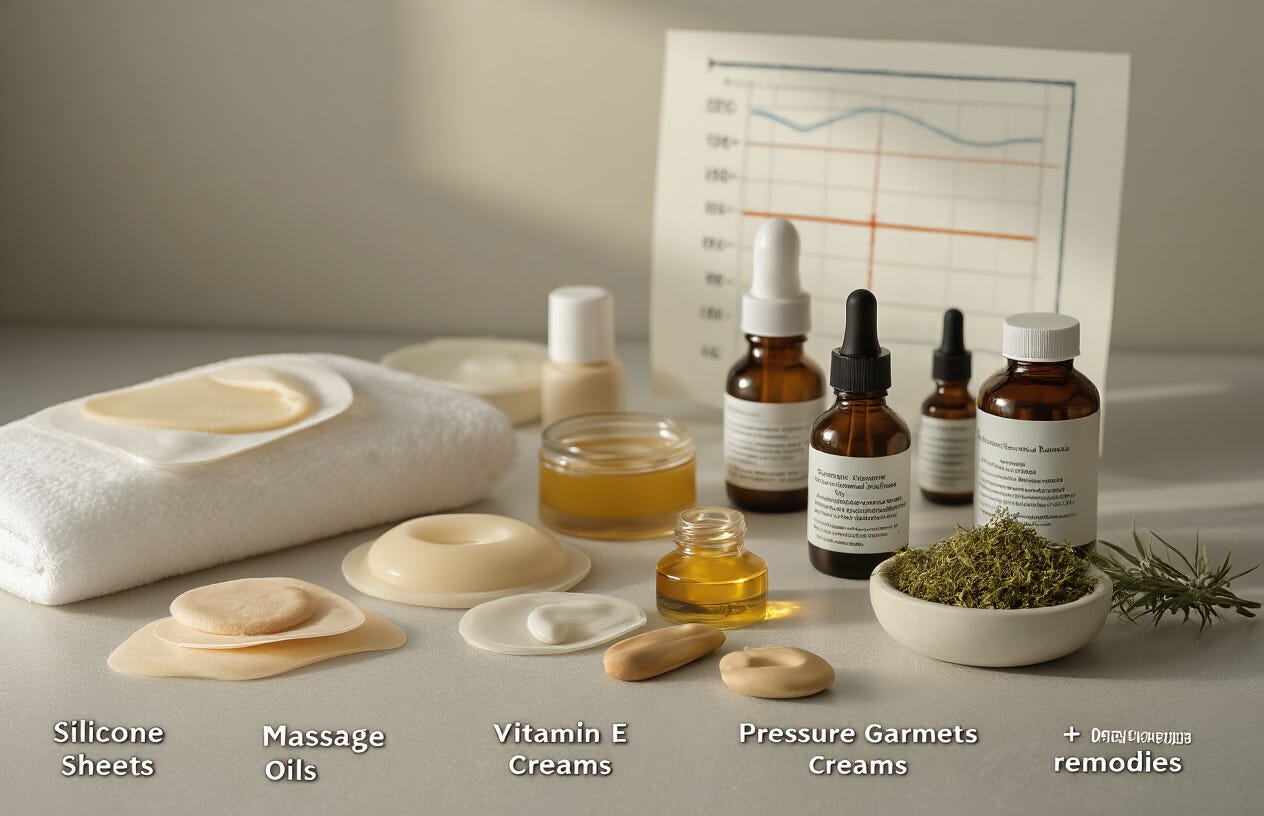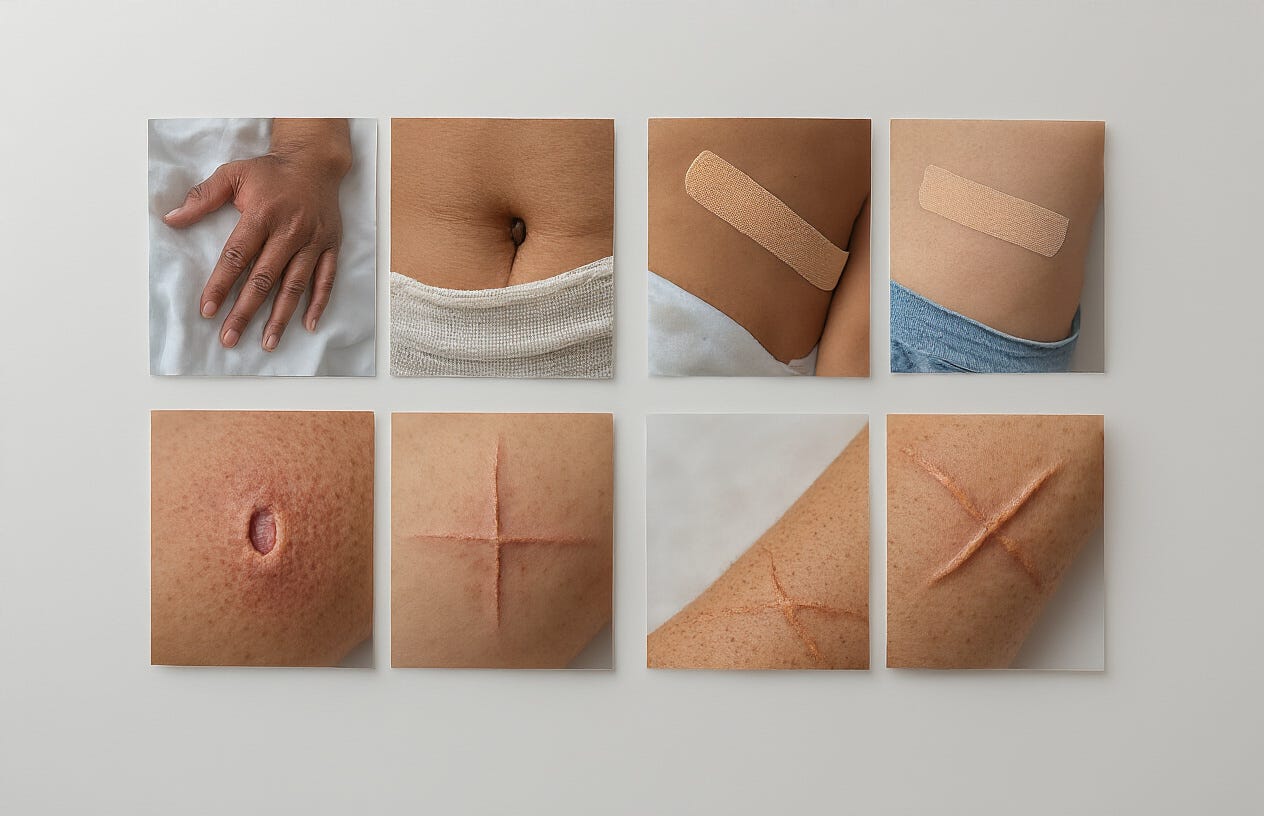Scar Tape/C-Sections
Picture this: you’re finally home with your new baby after a C-section, equal parts thrilled and exhausted. Then you catch a glimpse of your incision and think, “Will I always have this reminder?”
You’re not alone. With C-section rates climbing to nearly 32% of all births, more new moms are searching for ways to minimize their surgical scars. Scar tape has emerged as a popular solution for post-C-section recovery, promising less visible scarring without invasive procedures.
The truth is, how your scar heals depends on several factors—some you can control, others you can’t. But before you click “buy now” on that expensive silicone sheet set, shouldn’t you know what actually works?
Understanding the Rise in C-Section Deliveries

A. Current statistics and global trends
C-sections have skyrocketed in recent decades. Globally, rates jumped from 12% in 2000 to nearly 21% in 2022. That’s one in five babies worldwide entering the world through surgical delivery!
The numbers get even more eye-opening when you break them down by region. In North America and Western Europe, rates hover around 30-32%. Latin America takes the crown with Brazil hitting a staggering 55% – yes, more than half of all births!
Why does this matter? The World Health Organization suggests rates above 10-15% don’t actually save more lives. We’re way past that threshold in most developed countries.
B. Medical reasons for C-section recommendations
Doctors don’t suggest C-sections on a whim. Several legitimate medical situations make them necessary:
- Baby in breech position (feet or bottom first)
- Placenta problems (like placenta previa covering the cervix)
- Labor that stops progressing
- Fetal distress signals
- Multiple babies (twins, triplets)
- Previous C-sections
- Mom’s health conditions (severe hypertension, active herpes)
These situations represent genuine risks where surgical delivery truly saves lives. No argument there.
C. The impact of elective C-sections
Planned C-sections without medical necessity have dramatically contributed to rising rates. Some women choose them to avoid labor pain, schedule delivery, or based on misconceptions about vaginal birth damage.
But these come with trade-offs. Recovery takes longer – we’re talking major abdominal surgery here. Risk of complications like infection, blood clots, and breathing problems for babies runs higher. And of course, prominent scars become a permanent reminder.
The psychological impact varies wildly. Some women feel relief and control, while others experience disappointment or trauma if the C-section wasn’t planned.
D. How C-section rates vary by country and healthcare system
The differences between countries tell an interesting story about healthcare priorities:
Country C-Section Rate Healthcare System Netherlands 14% Midwife-led, low intervention Brazil 55% Private insurance incentivizes surgery USA 32% Insurance-based, litigation concerns Sweden 18% Universal healthcare, evidence-based
Healthcare payment structures play a huge role. Fee-for-service systems often have higher rates – surgeries pay better than long natural labors. Malpractice fears drive defensive medicine in some countries, with doctors choosing surgery to avoid potential lawsuits.
Cultural attitudes matter too. In some societies, C-sections are seen as modern or elite choices, while others emphasize natural processes whenever safely possible.
The Physical and Emotional Impact of C-Section Scars

A. Anatomy of a typical C-section incision
C-section incisions come in two main types: the bikini cut (low transverse) and the classical incision. Most doctors today use the bikini cut, which runs horizontally across the lower abdomen, just above the pubic hairline. It’s about 4-6 inches long and cuts through several layers—skin, fat, fascia (the tough tissue covering your abdominal muscles), the rectus muscles, the peritoneum (the membrane lining your abdominal cavity), and finally, the uterus.
The classical incision—a vertical cut from below your navel to your pubic bone—is rarely used now, except in emergencies or special circumstances.
B. Normal healing process and timeline
After your C-section, healing happens in phases:
Week 1-2: Initial inflammation. Your incision might look red, puffy, and feel tender.
Weeks 2-4: New tissue forms. The redness fades, but the scar might feel hard and raised.
Months 1-3: The scar begins to flatten and soften.
6-12 months: Full maturation. Your scar settles into its permanent appearance—typically a thin, pale line.
The timeline varies person to person. Some women heal faster, others slower.
C. Common concerns and complications
Most C-section scars heal without major issues, but complications can happen:
- Infection: Redness spreading beyond the incision, increased pain, fever
- Dehiscence: The wound partially or completely opens
- Keloids: Raised, thickened scars that grow beyond the original incision
- Hypertrophic scars: Raised, red scars that stay within the boundaries of the incision
- Numbness: Often temporary but can be permanent in some cases
D. Psychological effects of visible scarring
The emotional impact of C-section scars runs deeper than skin level. Many moms struggle with feelings of failure for not delivering “naturally.” The scar becomes a physical reminder of a birth experience that may have been traumatic or different than expected.
Some women view their scar positively—a badge of honor marking their child’s birth. Others feel disconnected from it, like it doesn’t belong on their body.
E. How scars can affect body image and confidence
C-section scars can shake up how you see yourself. That permanent mark might make you feel self-conscious in swimwear or intimate situations. Some women avoid certain clothes or activities because of their scar.
The impact goes beyond appearance. Some scars create physical discomfort—pulling sensations or pain—that affect how you move and feel in your body.
But here’s the thing—many women eventually make peace with their scar, seeing it as part of their motherhood journey. And with today’s scar management options, you have more control over how your scar develops than ever before.
Scar Tape: A Popular Solution for C-Section Scar Management

A. What is scar tape and how it works
Ever noticed those thin strips on a new mom’s belly? That’s scar tape – special medical-grade silicone strips designed specifically for healing scars. They work through two main actions: compression and moisture.
When you press that tape against your C-section scar, it applies consistent pressure that flattens and breaks down excess collagen (the stuff that makes scars thick and raised). At the same time, it creates this perfect microclimate of moisture that softens scar tissue and prevents it from getting dry and irritated.
The best part? It’s completely non-invasive. No chemicals seeping into your body, just physical forces doing what they do best.
B. Different types of scar tape products
Not all scar tapes are created equal. Here’s what you’ll find out there:
- Silicone sheets: The gold standard. These reusable, thicker sheets can last 1-2 weeks with proper care.
- Fabric-backed silicone strips: More flexible for active moms, these contour better to your body’s movements.
- Silicone gel strips: Thinner and less noticeable under clothing.
- Kinesiology-based options: Combine movement support with scar therapy.
Some popular brands include ScarAway, Mepiform, and Cica-Care, each with slightly different features and price points.
C. Application techniques for optimal results
Getting the most from your scar tape isn’t rocket science, but there are tricks:
- Always start with clean, dry skin. Wash the area with mild soap and pat dry.
- Trim the tape to extend about 1 inch beyond your scar on all sides.
- Remove backing carefully and apply without stretching.
- Press firmly for 30 seconds to activate adhesive.
- Wear for 12-23 hours daily (follow your specific product’s instructions).
- When removing, peel slowly toward the scar, never away from it.
Many moms find applying tape at night works best for their routine.
D. Expected benefits and realistic outcomes
Let’s be straight about what scar tape can and can’t do. It won’t make your scar vanish completely – nothing will. But consistent use (we’re talking 3-6 months) typically delivers:
- Flatter, less raised scars
- Reduced redness and discoloration
- Decreased itching and discomfort
- More flexible scar tissue that moves naturally with your body
The earlier you start using it (usually after your incision is fully closed), the better your results. Most women see noticeable improvement within 8-12 weeks.
Remember, genetics play a huge role in how you scar. Some people naturally heal with barely visible lines while others form more pronounced scars regardless of treatment.
Alternative Scar Minimization Methods

A. Silicone gel sheets and ointments
Looking for something beyond scar tape? Silicone gel sheets and ointments are top contenders. These products create a protective barrier that keeps your scar hydrated and reduces collagen buildup – the stuff that makes scars thick and noticeable.
Most moms find silicone sheets super convenient for overnight use. They’re reusable (usually for 1-2 weeks) and stay put while you sleep. The gel versions? Perfect for daytime when you need something discreet under clothes.
Studies show consistent silicone use can dramatically improve C-section scars when started about two weeks post-surgery. Many OBGYNs recommend brands like ScarAway, Cica-Care, and Kelo-cote.
B. Medical procedures (laser therapy, microdermabrasion)
Got a stubborn scar that won’t fade with at-home methods? Professional treatments might be your answer.
Laser therapy works by essentially resurfacing your skin and stimulating new cell growth. Fractional lasers create tiny injuries that prompt healing (sounds counterintuitive, but it works!). Most moms need 3-5 sessions spaced a month apart.
Microdermabrasion uses tiny crystals to exfoliate the skin’s surface, helping to fade discoloration and improve texture. It’s less intense than lasers and requires minimal downtime – perfect for busy moms.
C. Natural remedies and oils
If you’re all about keeping things natural, you’ve got options too.
Vitamin E oil is the classic go-to. Though research is mixed, many swear by its ability to soften scars when massaged in daily. Rosehip seed oil contains vitamins and essential fatty acids that can improve skin elasticity and reduce discoloration.
Shea butter, cocoa butter, and aloe vera are other popular choices that keep the scar area moisturized – crucial for proper healing.
Just remember: natural doesn’t automatically mean gentle. Always patch test first, especially if you’re breastfeeding.
D. Massage techniques for scar reduction
Your hands might be your most underrated scar-fighting tool. Regular massage breaks down adhesions (when scar tissue sticks to surrounding tissues) and improves circulation.
Start with gentle pressure about 6-8 weeks post-surgery (get your doctor’s okay first). Using your fingertips, make small circular motions around and over the scar for 5-10 minutes daily. Add a drop of oil for easier movement.
Cross-friction massage works wonders too – use your thumb to gently push perpendicular to the scar line. This helps reorganize collagen fibers for a less noticeable appearance.
Many physical therapists specialize in scar massage if you want professional guidance. Worth considering if your scar feels tight or restricts movement.
Choosing the Right Scar Treatment Approach

When to start treatment after surgery
Timing is everything when it comes to scar treatment. Wait too long and you’ve missed the window. Jump in too early and you might interfere with healing.
Most doctors recommend starting scar treatments about 2 weeks after your C-section, when your incision has closed properly. This is that sweet spot when your body is still actively remodeling the scar tissue.
The first 6 months after surgery? That’s your golden window. Your scar is still fresh and responsive to treatments. After that, results typically become less dramatic—though not impossible.
I’ve heard from countless moms who regret waiting a year to address their C-section scars. Don’t make that mistake.
Factors that influence treatment effectiveness
Not all scars (or bodies) respond the same way to treatments. Here’s what actually matters:
- Your genetics – Some people are simply predisposed to keloid or hypertrophic scars. Thanks, Mom and Dad!
- Skin tone – Darker skin tones often face higher risks of hyperpigmentation and pronounced scarring
- Age – Younger skin typically heals better (sorry)
- Incision type – The surgical technique used affects your final scar appearance
- Post-op care – How you baby that wound in the early days makes a huge difference
And the biggest factor? Consistency. The people who get the best results aren’t using miracle products—they’re using decent products religiously.
Combining multiple methods for better results
Why choose just one approach when you can stack them?
Most plastic surgeons recommend a multi-pronged attack on C-section scars. For example:
- Morning: Silicone sheets while you sleep
- Day: Scar massage with vitamin E oil
- Evening: Pressure therapy garments
This combination approach addresses different aspects of scar formation simultaneously. The silicone creates that moisture barrier, massage breaks up adhesions, and pressure therapy flattens raised scars.
Some moms swear by alternating weeks between different treatments to prevent the body from adapting. Smart move.
Cost considerations and insurance coverage
Let’s talk money—because this stuff adds up.
Premium silicone scar sheets can run $30-50 per sheet (which lasts 1-2 weeks with proper care). Professional laser treatments? Expect to drop $300-500 per session, often requiring 3-5 sessions.
Here’s the breakdown of typical costs:
Treatment Cost Range Insurance Coverage Silicone products $20-100 Rarely covered Steroid injections $50-300 Often covered with referral Laser therapy $300-500/session Sometimes covered for functional issues Scar revision surgery $1,000-3,000 Covered if medically necessary
Most insurance companies consider scar treatment “cosmetic” unless your scar causes physical restrictions or pain. Worth calling your provider though—some plans surprise you with coverage.
Real-World Results: What to Expect

Typical timeline for visible improvement
C-section scars don’t vanish overnight. Most women start seeing real improvements around the 6-8 week mark. By 3-6 months, that angry red line typically fades to pink or light purple. The full maturation process? That takes 12-18 months.
Here’s what the journey usually looks like:
Timeline What to expect 1-2 weeks Red, raised, possibly itchy scar 6-8 weeks Initial flattening, less redness 3-6 months Significant color fading, more flexibility 12-18 months Final appearance established
Before and after: realistic expectations
Scar tape isn’t magical. Those perfect, nearly invisible lines you see in advertisements? Often photoshopped or best-case scenarios.
The truth? Most C-section scars become thin, flat, pale lines. They don’t disappear completely. Your scar might end up 1/8 to 1/4 inch wide. It’ll likely be lighter or darker than your skin tone, depending on your natural pigmentation.
The biggest improvements happen in texture and height. That raised, bumpy scar typically flattens considerably with consistent treatment.
Factors that influence individual results
Some things you just can’t control:
- Genetics (thanks, Mom and Dad)
- Skin tone (darker skin tends toward more visible scarring)
- Age (younger skin heals differently)
- Pregnancy hormones
Things you can control:
- Consistent use of scar treatments
- Protecting the scar from sun exposure
- Proper nutrition and hydration
- Avoiding smoking (seriously, quit)
Long-term maintenance strategies
Once your scar matures, you’re not entirely done. Maintenance matters:
- Continue sun protection indefinitely (SPF 30+ directly on the scar)
- Moisturize regularly with vitamin E or cocoa butter
- Gentle massage to maintain softness
- Silicone sheets or gel for stubborn areas
Many women find seasonal touch-ups helpful, especially if their scar becomes more noticeable during certain times of year.
When to consult a dermatologist or plastic surgeon
Some red flags require professional attention:
- Scars that remain bright red beyond 6 months
- Significant pain, itching, or burning sensations
- Keloid formation (overgrown, spreading scars)
- Depression or emotional distress about your scar’s appearance
Don’t suffer silently if you’re unhappy with your results. Steroid injections, laser therapy, and microneedling can significantly improve stubborn scars, even years after your C-section.

The journey through C-section recovery doesn’t end with physical healing. Managing your scar effectively can significantly impact both your physical comfort and emotional well-being. Whether you choose scar tape, silicone sheets, massage techniques, or professional treatments, the most important factor is consistency and patience. Each healing journey is unique, but with proper care and the right approach for your specific needs, visible improvement is possible.
Remember that your C-section scar tells a powerful story of bringing life into the world. While minimizing its appearance is a valid goal, embracing this mark of motherhood is equally important. Consult with your healthcare provider to develop a personalized scar management plan that works for you, and give yourself grace throughout the healing process. Your body has accomplished something remarkable—treat it with kindness as it recovers.